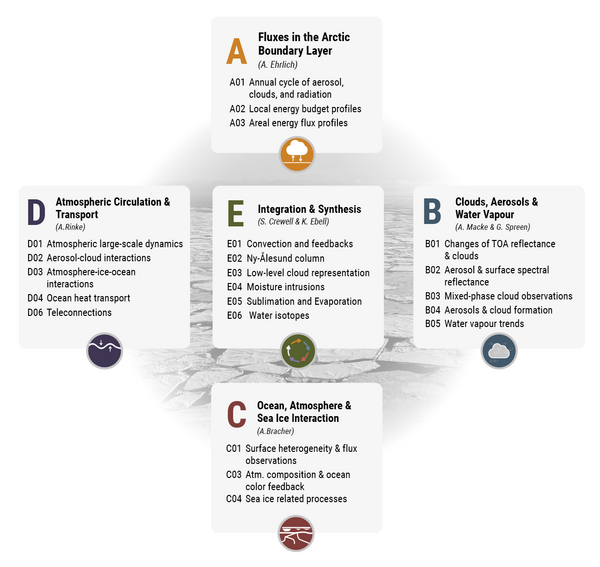Arctic Amplification: Climate Relevant Atmospheric and Surface Processes and Feedback Mechanisms (AC)³
The transregional research project “Arctic Amplification: Climate Relevant Atmospheric and Surface Processes and Feedback Mechanisms (AC)³” focuses on the multi-layered investigation of the increased warming of near-surface temperatures in the Arctic over the past decades, known as Arctic amplification. The aim is to identify and investigate the decisive processes and feedback mechanisms and to quantify their significance for Arctic amplification.
Background:
The Earth has warmed by an average of 0.87 K in the last 150 years. In the Arctic, this warming has been significantly stronger in recent decades, so that the near-surface air temperature in the mid-latitudes has warmed by 2K. The excessive warming of the Arctic in the 21st century is both a consequence and a driver of specific feedback processes that have led to drastic changes such as the decline in sea ice since around 1970. These feedback processes result in part from unique Arctic conditions such as temperature inversions, heterogeneous surfaces and persistent low clouds, as well as the exchange of heat, moisture and momentum between the ocean and atmosphere. The exact effects and interplay of these mechanisms are complex and difficult to quantify, leading to different interpretations of the interactions between Arctic warming and mid-latitude weather phenomena. Nevertheless, the AC3 project is investigating precisely this interaction.
Approach:
First, we have significantly increased our knowledge of important atmospheric processes, especially regarding Arctic mixed-phase clouds and their interaction with surface parameters, based on extensive measurements from field campaigns as well as long-term observations of ground and satellite data and corresponding simulations. As a result, the basis for a unique long-term assessment of Arctic climate change with satellite data was established and new satellite retrieval techniques were developed to accurately identify changes in key oceanic and atmospheric parameters. In addition, the representation of feedback mechanisms in atmospheric and climate models has been extended, e.g., by implementing new parameters. The overall objectives for Phase II are to identify, investigate and assess the key processes contributing to Arctic amplification, to better understand the local and global feedback mechanisms and to quantify their relative importance for Arctic amplification. We will implement four cross-cutting activities (CCAs) to take our research to a new, highly integrative level by combining campaign observations and long-term measurements (ground-based, ship, aircraft, satellite) with regional process and global climate modeling, covering the full annual cycle of Arctic climate change as well as the under-researched central Arctic.
Organization:
The research project is divided into 5 different project clusters that focus on different topics related to the phenomenon of Arctic amplification. These clusters are shown in Fig. X. In order to make fundamental and significant progress in our understanding of Arctic amplification, we will pursue the following three Strategic Questions (SQs):
- What are the main causes and their relative contributions to Arctic amplification?
- How do changes in meridional transports affect weather and climate in the Arctic and mid-latitudes?
- What trends caused by Arctic amplification can be identified and how will they evolve in a future warmer climate?


